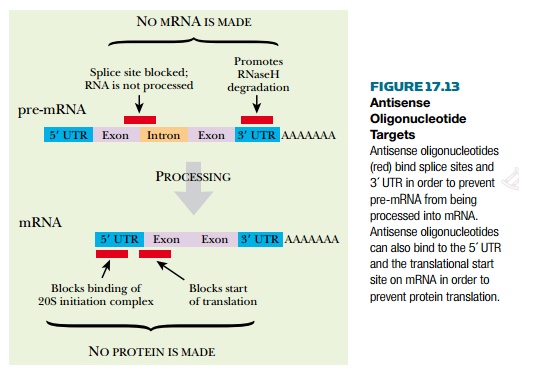Chapter: Biotechnology Applying the Genetic Revolution: Gene Therapy
Antisense RNA and Other Oligonucleotides
ANTISENSE
RNA AND OTHER OLIGONUCLEOTIDES
Antisense RNA binds to the corresponding messenger RNA and prevents its
translation by the ribosome.
Antisense RNA and related antisense nucleic acids are now being tested for
possible therapeutic effects. In most cases, the objective is to inhibit the
expression of a target gene. Two main alternatives exist when using antisense
RNA. First, it is possible to use a full-length anti-gene that is transcribed to give a full-length antisense RNA.
The anti-gene must be carried on a suitable vector and expressed in the target
cells. Second, much shorter artificial RNA oligonucleotides may be used. An
antisense RNA of 15 to 20 nucleotides is often capable of binding specifically
to part of the complementary mRNA and preventing translation.
The use of a full-length anti-gene has been tested experimentally against cancer cells in culture. Malignant glioma is the most common form of human brain cancer. Here the glial cells, which form the interstitial tissue between nerve cells, grow and divide in an uncontrolled manner. Often this is due to overproduction of insulin-like growth factor 1 (IGF1), which stimulates the growth and division of these cells. A vector carrying an anti-IGF1 gene was constructed by using the cDNA version of the IGF1 gene and simply reversing its orientation (Fig. 17.12). The anti-IGF1 gene was placed under control of the metallothionein promoter, which responds to trace levels of heavy metals. The vector was inserted into glioma cells in culture. Adding a low concentration of zinc sulfate turned on the anti-IGF1 gene, and the cancer cells stopped dividing and no longer caused tumors if injected into rats.

Artificial RNA
oligonucleotides may be aimed at a variety of possible sites on the target RNA.
They may be designed to block the 5′-end of a transcript, thus preventing
translation from beginning. However, other sites within the mRNA are often just
as effective. It is also possible to make an antisense oligonucleotide that
blocks the splice site of the primary transcript and so prevents formation of
the mature mRNA by the spliceosome (Fig. 17.13).

Antisense RNA
oligonucleotides are not very stable and are taken up poorly by many cells. Use
of liposomes to deliver antisense RNA may overcome the uptake problem. Another
way to overcome the first problem is to use modified oligonucleotides.
Antisense segments made of DNA rather than RNA are just as effective, are
easier to synthesize, and are more stable than RNA. Oligonucleotides with
phosphorothioate linkages are more stable than those with phosphodiester
linkages. Those made of peptide nucleic acid are extremely stable.
Antisense reagents are being
tested against malaria because of the shortage of effective antimalarial drugs
and the growing global incidence of this disease. Antisense oligonucleotides
(actually made of DNA with phosphorothioate linkages) have been used
experimentally to block synthesis of aldolase by Plasmodium falciparum,
the agent of the malignant form of malaria. Aldolase is the fourth enzyme of
the glycolytic pathway, and the blood stages of P. falciparum depend almost entirely on energy from glycolysis. The
antisense molecules targeted both the splice sites on the precursor RNA and the
translation start site on the mature mRNA. Aldolase activity dropped, the
malarial parasites ran short of energy, and growth and division of the
parasites were greatly reduced. Antisense reagents targeting topoisomerase II
and Clag9 (needed for attachment to CD36 protein of red blood cells) are also
being tested.
Related Topics